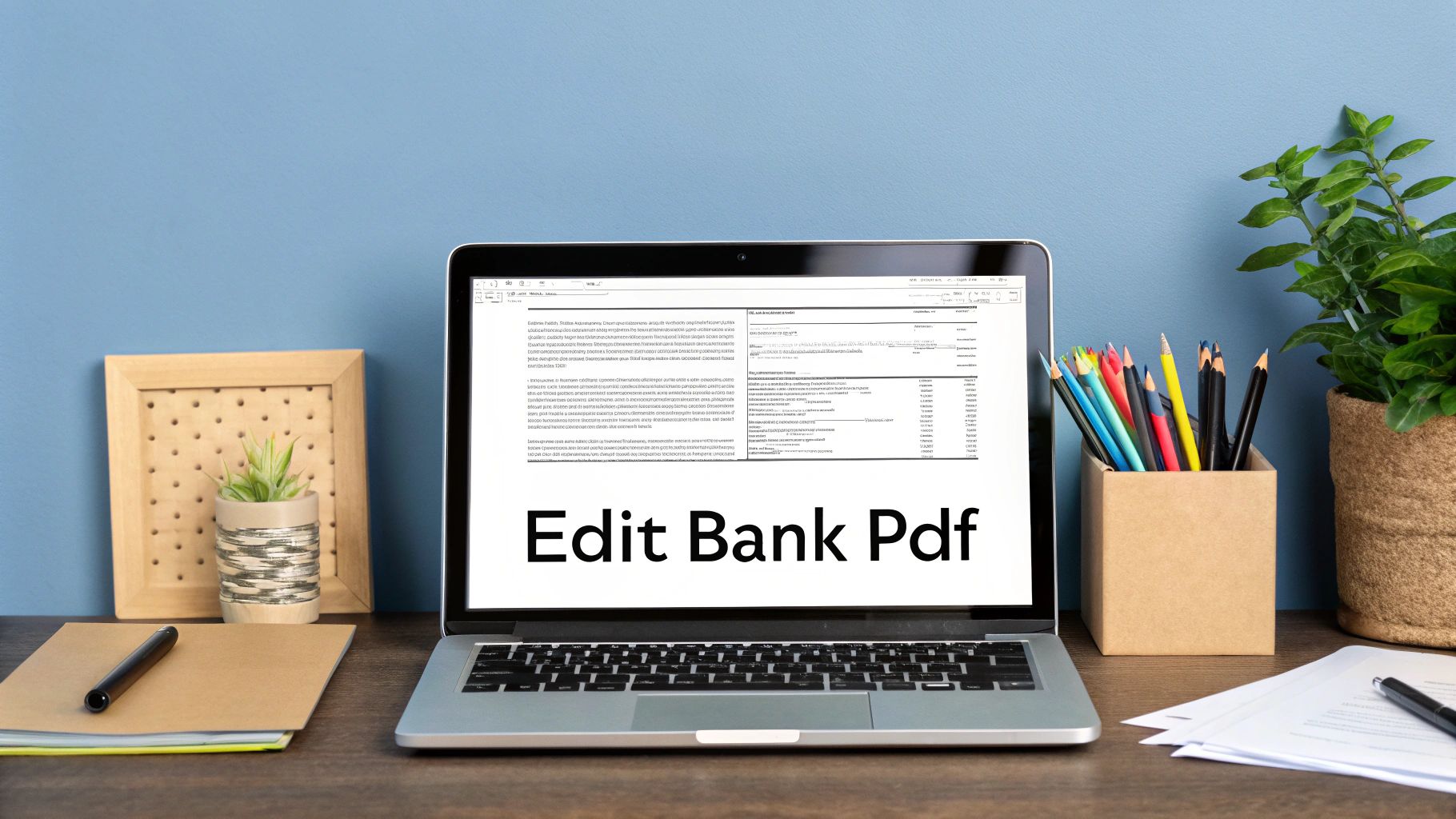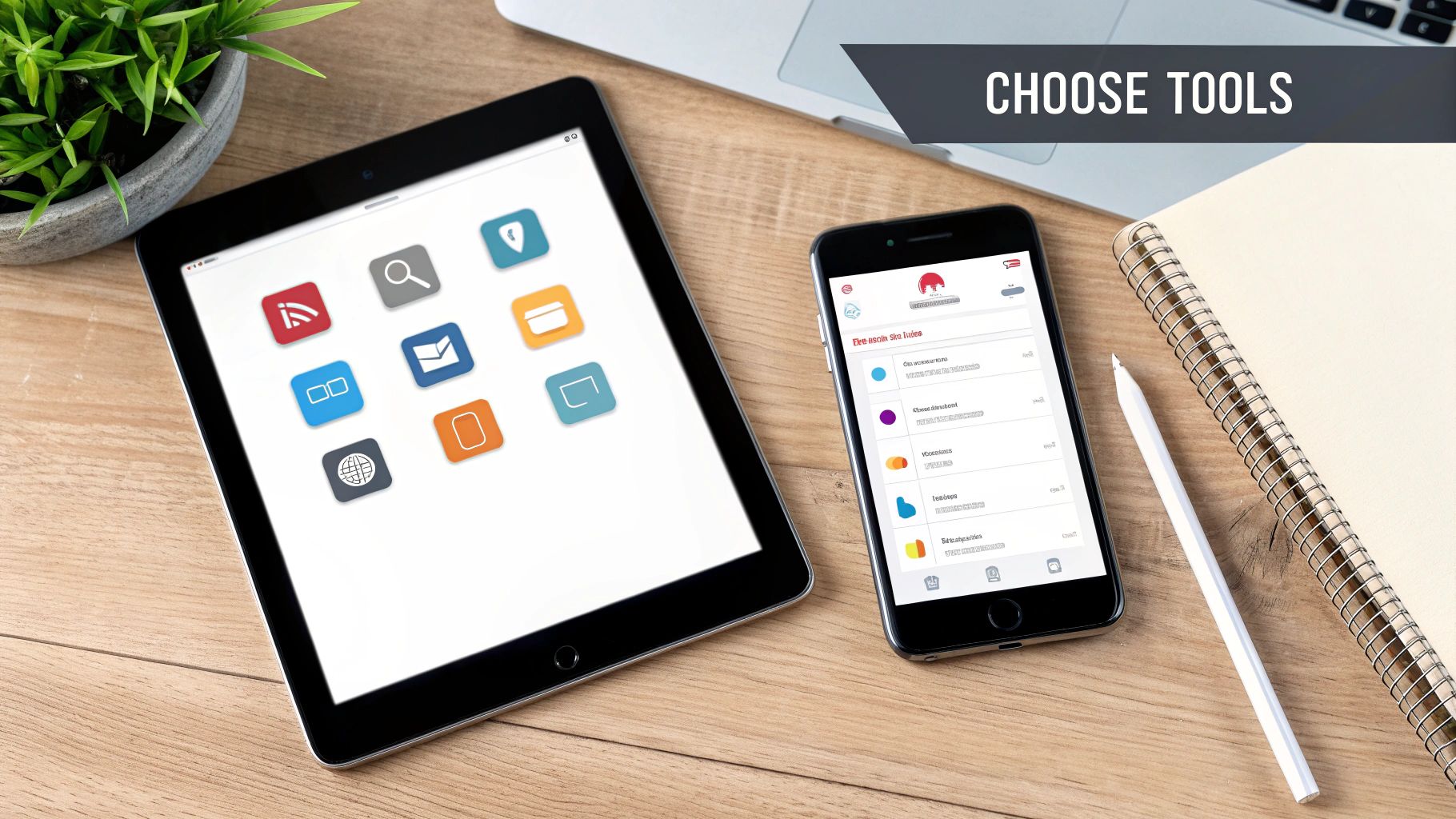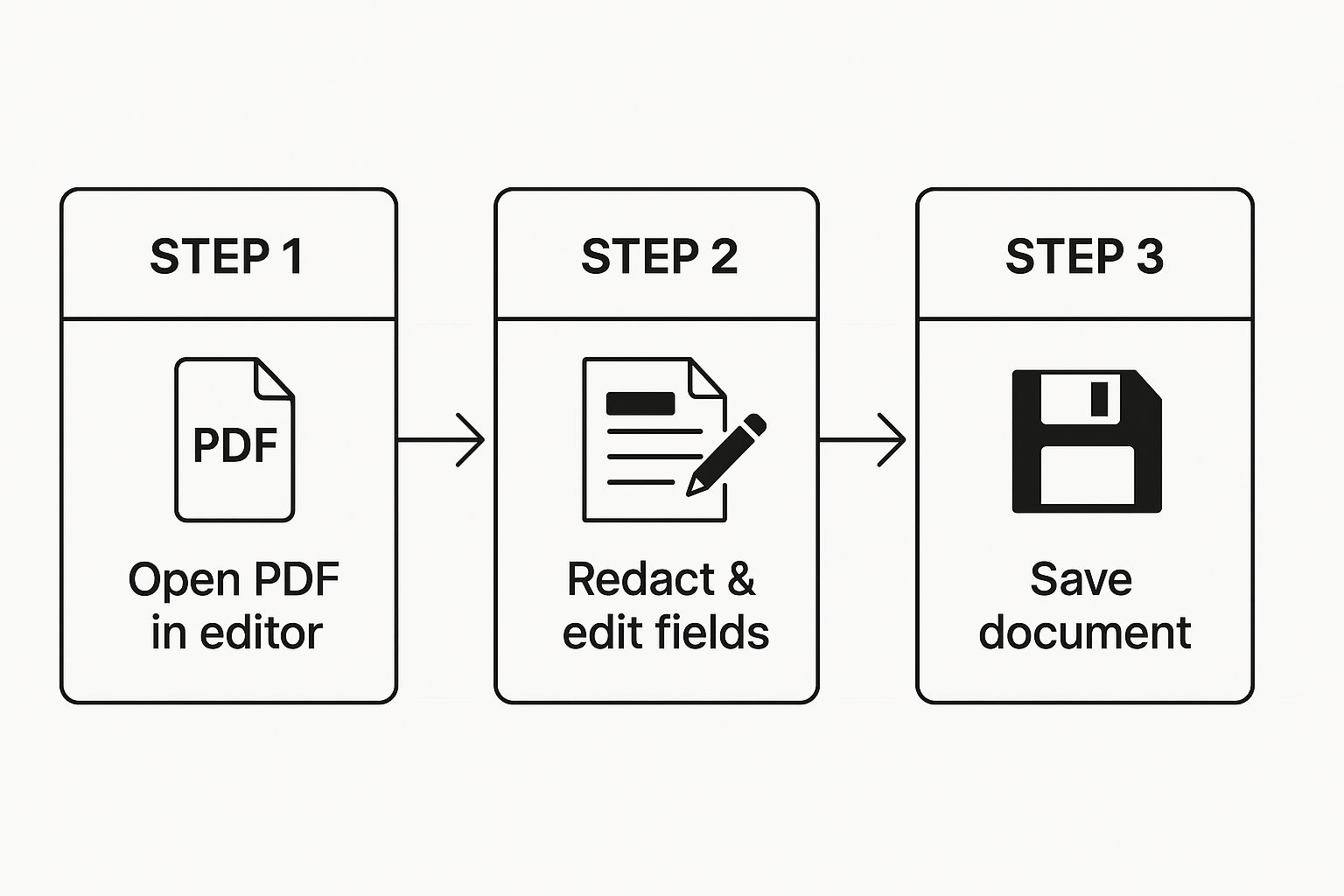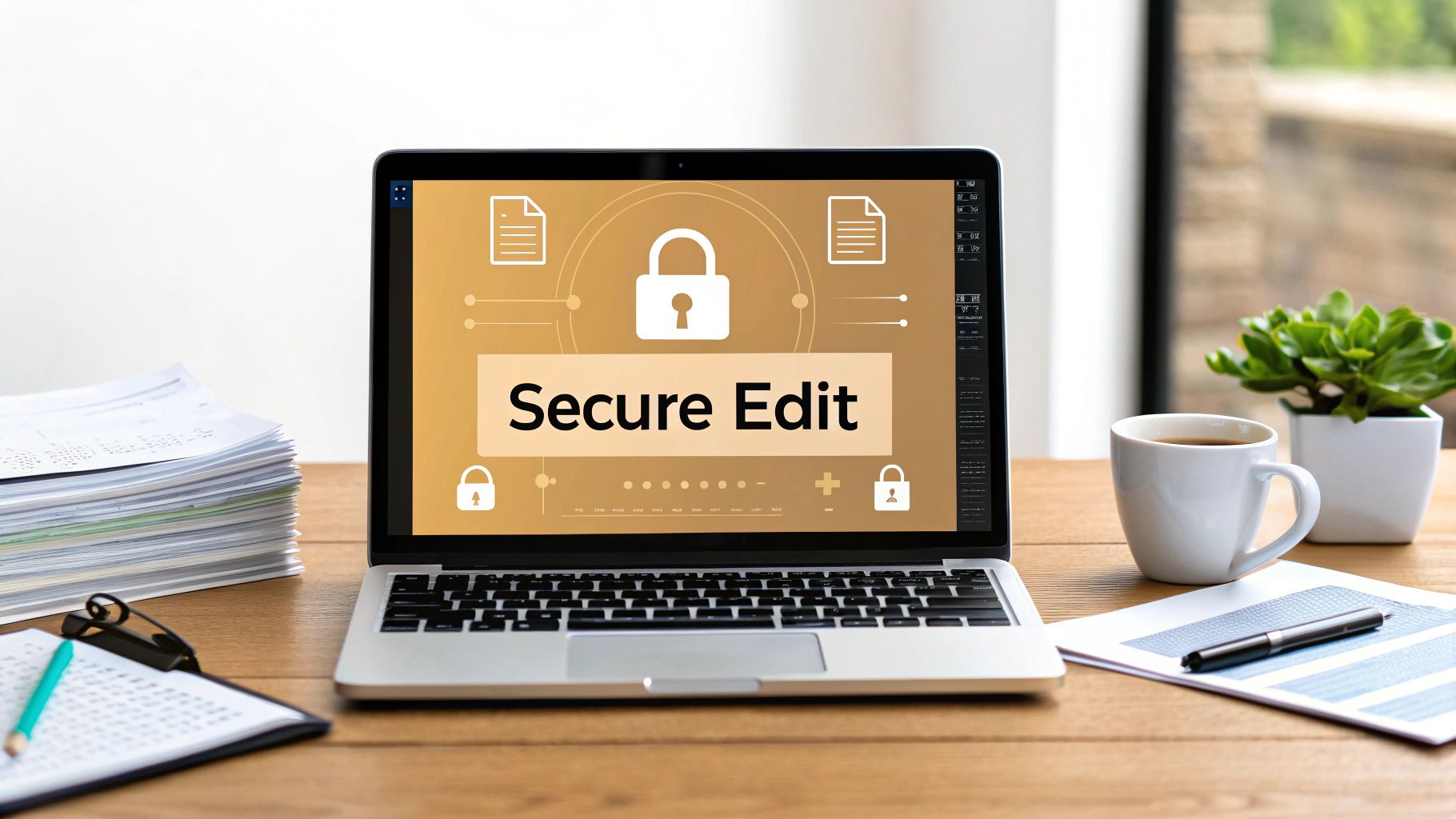With the right software, editing a bank statement PDF is actually pretty simple. People do it all the time for good reasons—mostly to protect their privacy or just to get organized. It’s all about using a secure PDF editor to black out sensitive details or add a few notes before you send it off.
This way, your private information stays private, but the core financial data remains completely accurate.
Legitimate Reasons to Edit a Bank Statement PDF

Before we jump into the "how-to," let's be crystal clear about the difference between making ethical edits and illegal alterations. Understanding what does a bank statement show is key here. Legitimate edits are all about adding clarity or boosting privacy, never about misrepresenting your financial situation. Getting this right is crucial for staying on the right side of the law.
Common and Ethical Editing Scenarios
I see a lot of valid situations where people need to make small, responsible changes to a bank statement. These edits are designed to help you share your financial info securely without changing the facts.
Here are a few real-world examples I run into all the time:
- Redacting Sensitive Information: This is the big one. Let's say you need to provide a statement as proof of address. You'd want to black out your account number and maybe some transaction details. No one needs to see that you bought a coffee yesterday. This is the most common reason people learn to edit these files.
- Annotating for Clarity: You can add notes to explain certain transactions for your own records, like for budgeting or tax prep. I often add quick notes like "Client lunch" or "Office supplies" next to charges to make my expense tracking easier later on.
- Preparing for Loan Applications: When applying for a loan, highlighting your main income sources or adding a quick note to explain a large, one-time deposit can really help a lender understand your finances. It can make the whole process go a lot smoother.
The bottom line is simple: any edit made to deceive someone about your financial reality is fraud. The goal here is always transparency and data protection, never manipulation.
The need for secure document tools has caused the PDF editor software market to explode. It was valued at USD 3.97 billion and is expected to hit a massive USD 17.71 billion by 2033. You can see more about the PDF software market growth on businessresearchinsights.com. This growth just proves how important it's become for people to manage sensitive documents like bank statements safely.
Choosing a Secure PDF Editor for Financial Documents

When you need to edit a bank statement, the PDF software you pick is your first and most important line of defense. It's a critical choice. Many people make the mistake of using the first free online tool they find, but that's a huge gamble with your financial data. Most of these services require you to upload your statement to their servers, which opens up a massive privacy risk.
A much safer approach is to use a dedicated desktop application. Software like Adobe Acrobat Pro keeps everything local. Because the file is processed on your own computer, your bank statement never leaves your control, which dramatically cuts down the risk of someone else getting their hands on it.
What Security Features Actually Matter?
Beyond just choosing a desktop app, you need to look at the specific features a PDF editor offers. Real security is about more than just editing text. For example, simply drawing a black box over an account number isn't enough—the original data often still exists underneath and can be easily uncovered.
Here are the features I consider non-negotiable for handling financial documents:
- True Redaction: This is the big one. It permanently removes the data from the document file, not just hides it. It’s the only way to be 100% sure that sensitive information is gone for good.
- Password Encryption: A good editor will always let you lock the file with a strong password. This adds a crucial layer of protection, especially if you plan on sending the document to someone else.
- A Clear Privacy Policy: Before you install anything, take a minute to read the company's privacy policy. If they mention processing your data on their servers, you need to know exactly how they handle it, for how long, and who has access.
A secure PDF editor isn't just a tool; it's an investment in your financial privacy. The convenience of a free online editor is rarely worth the risk of exposing your entire financial history.
PDF Editor Comparison for Bank Statements
To make the choice clearer, here’s a quick breakdown of the different types of editors and where they fit best.
| Editor Type | Key Features | Security Level | Best For |
|---|---|---|---|
| Free Online Tools | Basic text editing, simple annotations, file conversion. | Low | Quick, non-sensitive edits where privacy is not a concern. |
| Desktop Software | True redaction, advanced editing, password encryption, local processing. | High | Editing bank statements, legal contracts, or any confidential document. |
| Secure Cloud Platforms | Collaborative editing, version history, access controls, robust encryption. | High (with reputable providers) | Teams of accountants or businesses needing secure, remote access to documents. |
Ultimately, for something as sensitive as a bank statement, sticking with a trusted desktop or secure cloud solution is the only responsible choice.
What's Happening in the Market
The demand for both security and flexibility is shaping the industry. We're seeing a clear shift toward cloud-based PDF solutions, which now account for about 62% of the market, with on-premise software making up the other 38%. According to a market analysis by Dataintelo, this trend is growing fast, with regions like Asia-Pacific expected to see a 12.3% compound annual growth rate through 2032.
While cloud tools offer the amazing benefit of editing a bank statement from anywhere, you have to be extra diligent about choosing a provider with ironclad security protocols. For professionals like accountants who handle dozens of client files, this decision is even more critical. If that's you, our guide on the best document management software for accountants can help you navigate those specific needs.
How to Securely Edit Text in Your Bank Statement
Once you have a reliable desktop PDF editor fired up, you're ready to make your changes. The whole point here is to keep the edits clean and professional. You're not trying to alter the financial facts, but rather organize the information for a specific need—like blacking out sensitive data before sharing it.
Getting started is usually pretty simple. Most good editors, like Adobe Acrobat, have an "Edit PDF" tool. Clicking it will often reveal bounding boxes around all the text and image elements on the page. This lets you click in and type, almost like you're working in a Word document. This is where you need to be careful and precise.
Making Precise and Professional Edits
Let's walk through a common scenario. Say you need to provide a bank statement to a new utility company just to prove your address. For privacy, you'll want to remove your account number and maybe a few other personal details.
Instead of just drawing a black box over the text (which can sometimes be removed), the right way to do this is with the redaction tool. This feature doesn't just cover the information; it permanently erases it from the document's data layer. It’s the only truly secure way to hide information.
What if you need to add a note? Maybe you want to clarify that a vague "Miscellaneous Debit" was actually for "Office Supplies" for your records. Here’s how you’d handle that:
- Find and click into the text area next to the transaction.
- Type in your clarifying note.
- Next, you'll want to match the font. Most statements use standard fonts like Arial or Times New Roman, typically around 9pt or 10pt. Use the editor’s formatting options to make your addition look like it belongs there.
This simple workflow—opening the file, making your changes, and saving a new version—is key to doing this correctly.

Following these steps ensures you always have the original, untouched statement to fall back on.
Saving Your Edited File Correctly
After you’ve made your edits, this last step is absolutely critical for good record-keeping. Never, ever save over your original file. Always choose the "Save As" option to create a completely new document.
I’ve learned from experience to rename the new file with a clear label. For instance, I'll turn "January_Statement.pdf" into "January_Statement_Redacted.pdf" or "January_Statement_Annotated.pdf". This tiny habit has saved me from countless headaches by creating a clear audit trail.
Once you’ve saved your work properly, you’re done!
If you're looking to do more than just edit, like pulling all your transactions into a spreadsheet for budgeting, you might want to learn more about how to extract data from PDF files. It can be a massive time-saver compared to typing everything out by hand.
Security Practices for Handling Financial PDFs
Knowing how to edit a bank statement PDF comes with serious responsibility. When you're dealing with documents this sensitive, your digital security habits are every bit as important as the software you use. A simple mistake can expose your private financial data or, even worse, put you in legal jeopardy.
Let’s be crystal clear: altering a statement to misrepresent your financial situation is fraud, plain and simple. It carries severe legal consequences. Legitimate editing is about improving privacy and clarity—like redacting a social security number before sharing—never about deception.
Essential Security Habits
A few core practices can make a world of difference in keeping your information safe. Think of this as your go-to security checklist before you even open a financial document.
- Stick to Secure Wi-Fi: Avoid editing financial documents on public Wi-Fi, like at a coffee shop or airport. These networks are often unencrypted, making it alarmingly easy for someone to snoop on your activity and intercept your data. Always work from a trusted, password-protected network.
- Password-Protect Your Files: When you're done editing, always encrypt the PDF with a strong, unique password. This is your last line of defense. If the file ever ends up in the wrong hands, the password will keep the contents locked down and unreadable.
- Know What Real Redaction Is: Just drawing a black box over an account number isn't enough. With basic PDF tools, those boxes can often be moved or deleted, revealing the information underneath. You need to use a proper redaction tool that permanently removes the data from the file itself.
Your goal is to create a secure bubble for your financial information. This means protecting the file itself, the network you're on, and the integrity of the data you're sharing.
Safeguarding Your Digital Environment
The security of your computer and your network is the foundation of it all. To really lock things down, it's worth adopting the broader principles detailed in these 10 essential network security best practices.
The need for secure editing is only growing, especially with financial regulations that demand document integrity and clear audit trails. This is why you're seeing more PDF editors built with integrated cloud storage and serious encryption—features that are absolutely critical for handling private financial information.
The technology for securely scanning and processing documents, which you can read about in our article on OCR in banking, is also a key part of maintaining that document integrity from the very beginning.
Common Mistakes That Can Sabotage Your Document

When you're figuring out how to edit a bank statement PDF, it's the small slip-ups that can completely undermine your work. These little errors can make your edits look obvious or, even worse, leave your sensitive financial data exposed. Getting a handle on these common pitfalls is crucial for keeping your documents looking professional and truly secure.
A classic giveaway of an amateur edit is a mismatched font. It’s the first thing that jumps out. If the text you add is a different typeface, size, or even weight than the rest of the document, it practically screams "edited." Always take a minute to identify the original font and match it as closely as possible.
Another rookie mistake is simply hitting "Save" instead of "Save As." This destroys your original, untouched file forever. You’re left with no clean copy for your records or for future reference. Get in the habit of always saving a new, distinctly named version of the edited document.
The Number One Security Risk
The single most dangerous mistake people make is how they try to hide sensitive information. Drawing a black box over an account number or social security number feels secure, but it's not. This just lays a colored shape over the text, and anyone can often just copy and paste that "hidden" text into another program to reveal the original data. It's a disaster waiting to happen.
Proper redaction is the only way. A real redaction tool doesn't just cover up information; it permanently removes the underlying data—the pixels and text code—from the PDF file itself. Once it's gone, it's impossible to recover. Anything less is a flimsy visual trick that puts your financial details at risk.
By sidestepping these common blunders, you can ensure your edits are clean, effective, and genuinely secure. It’s about protecting both the document's integrity and your own private information.
Common Questions About Editing Bank Statements
When it comes to modifying a bank statement PDF, a few important questions always come up. Getting these right is crucial for handling your financial documents properly and securely.
So, Is It Actually Legal to Edit a Bank Statement?
Absolutely. It's perfectly legal to edit your own bank statement for personal use. I do it all the time. A common scenario is blacking out your account number for privacy before sending the document as a proof of address. Another great use is adding your own notes next to transactions to keep track of spending for your budget.
Where you cross the line, though, is intent.
It becomes illegal and is considered fraud the moment you alter key financial details—like your balance or transaction history—with the goal of misleading someone else, like a potential lender or landlord. The key is honesty. Edits for your own privacy or organization are fine; edits meant to deceive are not.
What's the Safest Way to Go About It?
Your best bet is to always use a trusted, offline PDF editor that you install directly on your computer. When you use those free online tools, you're often uploading your sensitive financial data to a third-party server, which can be a major security risk. Working offline keeps your information strictly on your own device.
When you're choosing a tool, make sure it has these two features:
- Proper Redaction: This feature permanently deletes the data you want to hide. It's far more secure than just drawing a black box over the text, which can sometimes be removed by a savvy user.
- Password Protection: Encrypting the file adds a powerful layer of security. This way, even if the document ends up in the wrong hands, it’s unreadable without the password.
Can I Change a Scanned Bank Statement?
You can, but you'll need a specific tool for the job. A standard PDF editor won't work on a scanned image. You need software that includes Optical Character Recognition (OCR).
OCR is a smart technology that scans the image of your document, recognizes the letters and numbers, and turns them into actual, editable text. Once the OCR process is complete, you can modify the scanned statement just like you would a regular, digitally-created PDF.
Ready to take control of your financial data? Bank Statement Convert PDF offers powerful tools to convert your bank statement PDFs into organized Excel spreadsheets, making analysis and budgeting easier than ever. Learn more and get started today!


